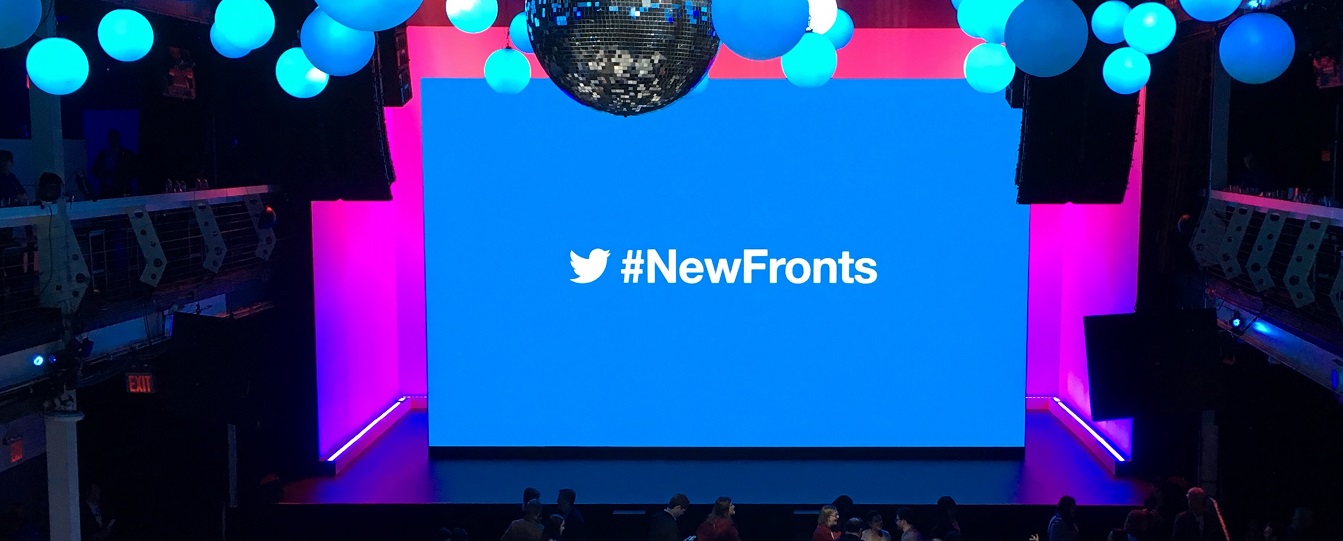 APPS
APPS
 APPS
APPS
 APPS
APPS
Three media companies delivered their digital content presentations at NewFronts in New York City on Monday, as they do every year. Two had far-flung networks of global correspondents, teams of editors and a combined 263 years of communications experience, but the third one that dominated the headlines on this day was founded in 2006 and its primary product started as only 140 characters long.
Although the New York Times Company and BBC News tried hard to impress advertising and marketing executives, Twitter Inc.’s joint announcement with the Walt Disney Co. that the pair will create live content throughout the full Disney portfolio of shows on the social media giant’s platform sent a stronger signal that the company is ready to become a force in digital content and advertising.
Twitter’s rollout in New York this week resembled recent Amazon Web Services Inc.’s conference keynotes as one new offering followed another, nearly 30 in total, over the course of the nearly two-hour presentation. In addition to the Disney deal, which includes sports programming with ESPN, Twitter announced new partnerships to create content with NBCUniversal, Vice Media, Will Packer Media and Viacom. The company also renewed previous agreements with Major League Baseball, Major League Soccer and Live Nation Entertainment.
“We want to continue to serve the public conversation,” Jack Dorsey, co-founder and chief executive of Twitter, said at the end of the announcement parade. “It’s what we love.”
The remaining question is whether advertisers will love the new digital content enough to spend significant dollars on Twitter, even though there is clearly momentum in that direction. Marketers plan to spend $70 billion more on digital advertising by 2020, while additional ad spending for other content platforms, including television, will come to only $1.6 billion.
Since acquiring Periscope in 2015, Twitter has moved aggressively to define its role in video content. Prior to Monday’s news, Twitter had found its place in the video sun with streaming content from “Game of Thrones” and the National Football League. The Disney deal shows how far the company has come in only three years.
In April, Twitter declared that video now accounted for over half of its ad revenue and represented its fastest-growing format to date in the first quarter of 2018. The NewFronts announcements spiked Twitter’s stock over 4 percent on Monday after shares rose more than 20 percent in February alone.
In contrast, the New York Times offered its answer to the video content wave: Stay tuned. Newspaper executives indicated that the Times had major plans to develop video content, but nothing was formally announced. The only hint provided was that its “The Daily” podcast, which debuted a mere 15 months ago, would likely become videostreamed soon.
The podcast has proven to be a major hit for the venerable news organization. Executives disclosed on Monday that it has been downloaded 280 million times and has a listenership of a million subscribers. “The Daily has more listeners than the weekday paper has ever had,” said Meredith Kopit Levien, the Times’ chief operating officer.
Times executives also revealed that the newspaper is pursuing the migration of its content to a digital assistant platform, such as Amazon Alexa, part of a strategy described as “service journalism.” Newspaper experts can offer a daily news summary on command or provide helpful tips on removing a stain from a shirt.
“Voice is an ideal interface for service journalism,” said Marc Lavallee, the head of research and development at the Times. “Every brand can create a voice presence that solves any problem.”
The Times is also delving into the world of data science. New tools described during NewFronts such as NYTReaderScope will employ machine learning to analyze reader profiles and ProjectFeels will draw on user emotions to assist advertisers.
“Prepare for a future that’s not going to look anything like our past,” said Sebastian Tomich, global head of advertising at the Times.
Meanwhile, the BBC was the only one of the three companies to announce new initiatives in virtual and augmented reality. BBC News announced a documentary series presented in 360-degree video that will use a VR interface to let users travel through sites around the world. The organization also unveiled an AR app that features top chefs teaching recipes in the comfort of one’s own kitchen.
Hovering over the NewFronts presentations in New York like a gray cloud is the issue of brand safety. The controversy surrounding Facebook’s use of user data and concerns about the impact of fake news in U.S. elections have elevated the importance of digital content trust.
Streaming of major events in real time may help all three firms mitigate concerns and reassure the ever-critical advertiser community. Twitter believes its newly announced digital content will boost credibility as a viable source of information, and the Times and BBC News are clearly counting on their respected brands to allay marketer and user fears.
At a NewFronts presentation on Monday, Jim Egan, BBC’s chef executive of global news, described a previous trip to New York and his journey through customs. Asked about the purpose of the visit, Egan disclosed somewhat nervously that he worked for the British news organization. “BBC News, you’re the ones who don’t make it up, right?” the customs agent asked. “It was the best welcome to the United States I ever had,” Egan said.
Support our mission to keep content open and free by engaging with theCUBE community. Join theCUBE’s Alumni Trust Network, where technology leaders connect, share intelligence and create opportunities.
Founded by tech visionaries John Furrier and Dave Vellante, SiliconANGLE Media has built a dynamic ecosystem of industry-leading digital media brands that reach 15+ million elite tech professionals. Our new proprietary theCUBE AI Video Cloud is breaking ground in audience interaction, leveraging theCUBEai.com neural network to help technology companies make data-driven decisions and stay at the forefront of industry conversations.